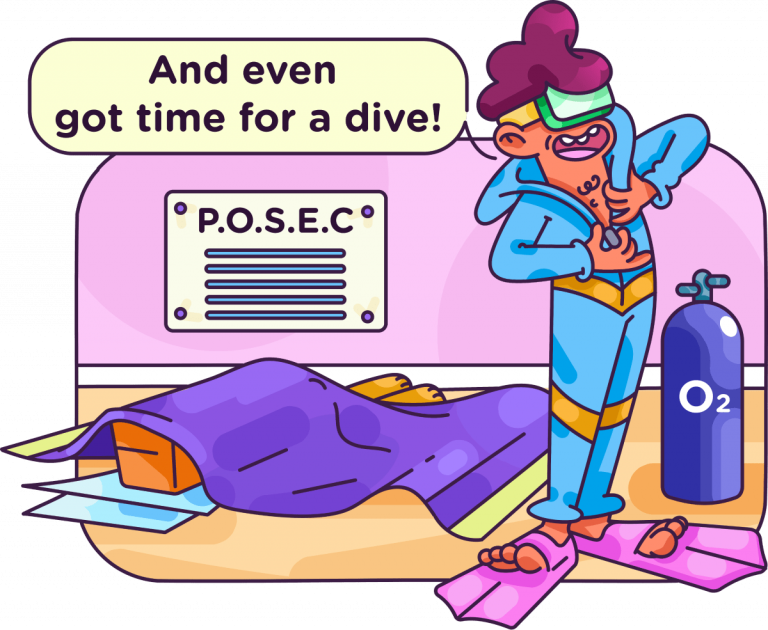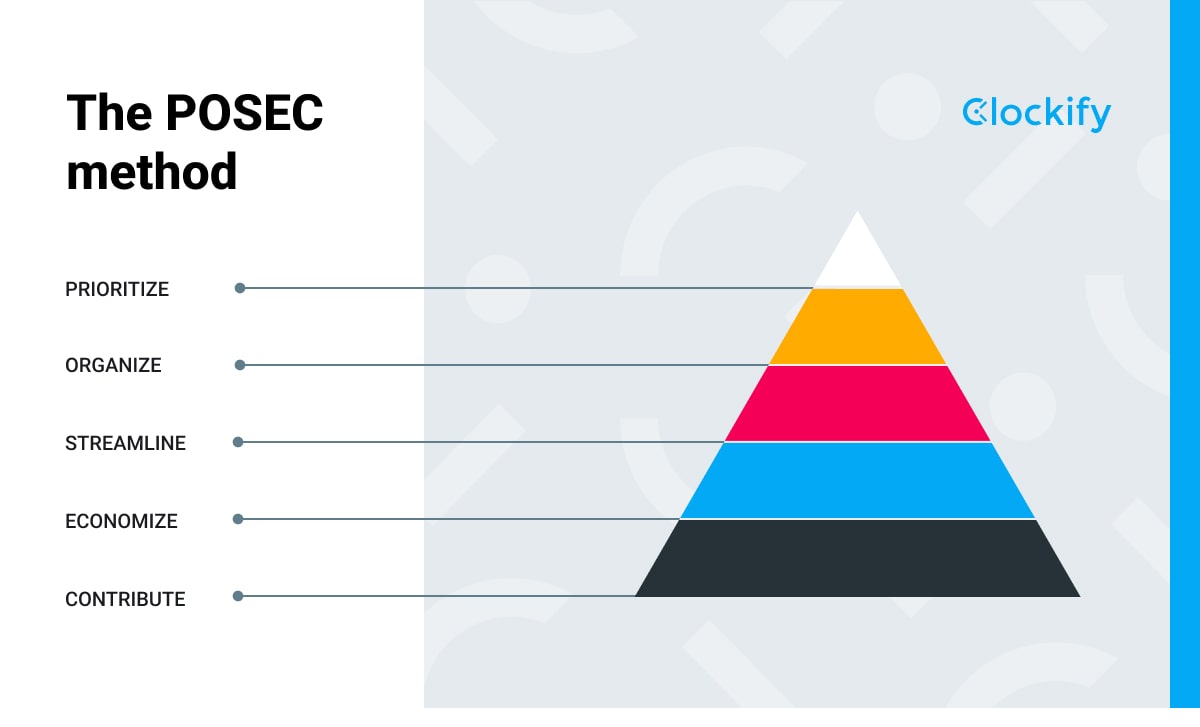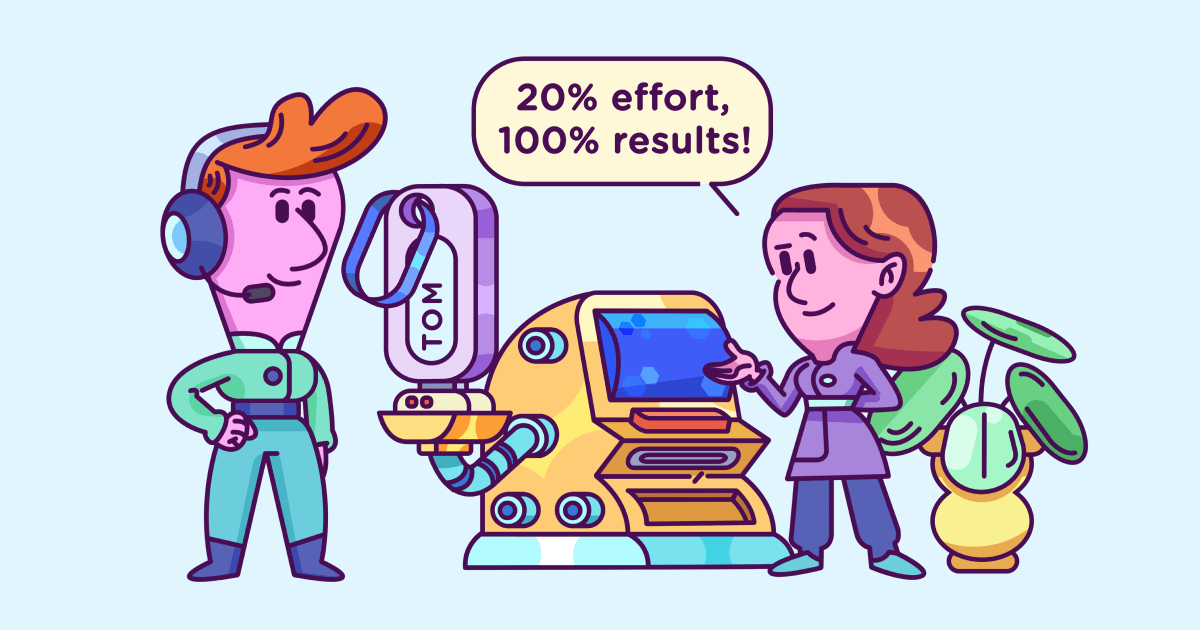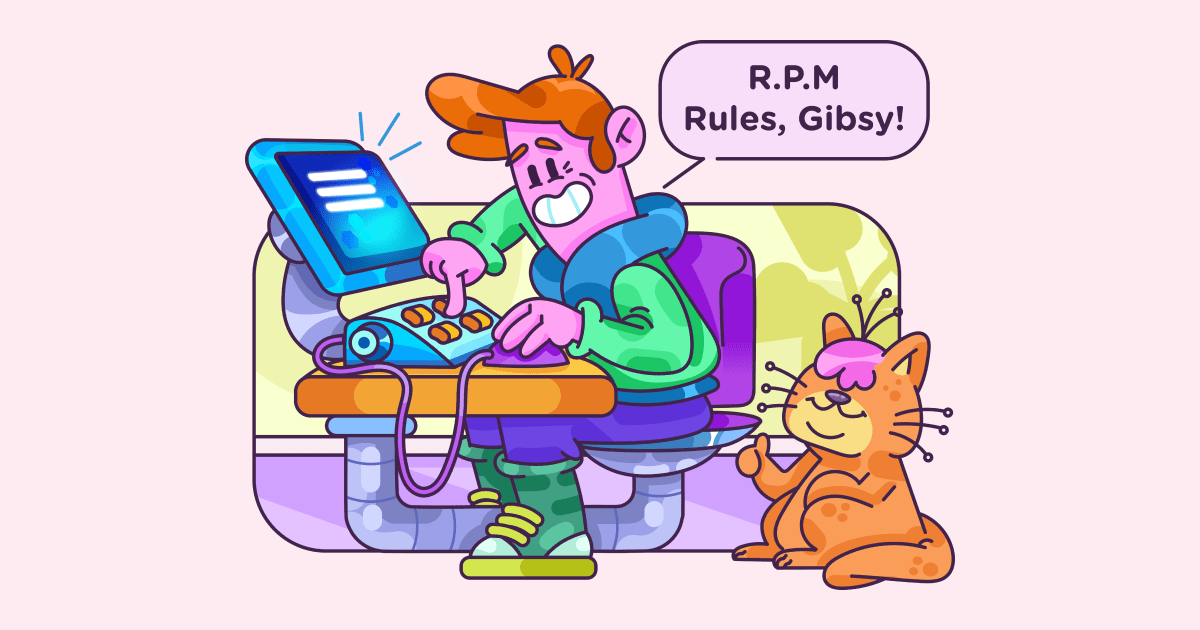I tried managing my time with the POSEC method
Last updated on: October 17, 2022
How many time management methods have you tried this year so far?
Did they all speak to your soul and promise to revolutionize your day?
From the get-go they usually all seem to work pretty well. But then, somewhere around day two or three, 5 p.m. creeps up on you, and your to-do list is still a mile long.
(I may or may not be speaking from experience.)
But, don’t we all deserve some peace of mind without our long overdue tasks secretly sabotaging our free time?
I’d say we do, but I’m not an expert.
Still, what I do know for sure is that nobody deserves to go through testing yet another time management technique only to fall right back into their old habits two days after — that’s why I’m here.
This time, I tested the POSEC method for a week, and I’m about to let you in on whether this time management hack really works or if you should give it a pass.

Table of Contents
What is the POSEC method?
If you have ever googled the POSEC method (which you must have, since you ended up here), you might have noticed that there’s a veil of mystery surrounding this time management method.
When you look up other popular time management techniques, such as bullet journal time tracking, for example, you’ll notice a link or a reference leading you to the original creator of the method.
But, that’s not the case with the POSEC method.
The Internet claims that the POSEC method was created by Steven Lam. However, you won’t find any quotes or links proving this claim.
Still, somebody did come up with this method, and they based it on Maslow’s hierarchy of needs that instructs us to meet our basic needs first (such as food and shelter) and focus on higher-level goals second.
However, unlike Maslow’s pyramid, the POSEC method is supposed to nudge you into achieving your goals while not giving up on your personal life.
The five principles of the POSEC method
Now that we’re clear on what the POSEC method is, you’re probably wondering how this unusual technique actually works.
Well, POSEC is an acronym that stands for:
- Prioritizing,
- Organizing,
- Streamlining,
- Economising, and
- Contributing.
By following each of the principles in the order they are listed, you will reach your goals and get the most out of your days.

At least that’s what’s supposed to happen.
But let’s take a closer look at each of the POSEC method principles and see how to put this time management technique into practice.
POSEC principle #1: Prioritize
The first principle of the POSEC method is all about breaking down your goals to detect the steps that will get you to the finish line.
For example, if you’d like to finish a long-term project at work or learn a new language, give careful thought to the steps you should take to get to the finish line and eliminate all the tasks that feed into your day but don’t bring you any value compared to your ultimate goal.
Long story short — set your priorities before getting down to a task.
POSEC principle #2: Organize
Although the second principle might seem like a nickname for the first one, organizing your tasks is the step that naturally comes right after you’ve figured out what exactly needs to be done.
Start by putting all your priorities on a list and then work your way through organizing them based on their importance.
You can decide to draft a to-do list or even plot your entire week’s schedule in detail by strategically ranking your tasks and setting aside different blocks of time for each of them.
💡 Clockify Pro Tip
Did you know that your level of productivity depends on the type of to-do list you decide to create? Pick a to-do list that suits your workflow best without having to test it out first:
POSEC principle #3: Streamline
Remember all the tasks you eliminated while you were trying to list your priorities?
Now they come back to haunt you.
OK, that might not exactly be true — but, the third principle of the POSEC method claims that you won’t be able to succeed unless you give a chunk of your time to tedious tasks (such as washing dishes or sending emails) too.
Still, the fact that you need to give your attention to chores doesn’t necessarily mean that you are not allowed to find the simplest way to deal with them — and that’s what streamlining is all about.
Think about whether there’s any task that you can:
- Delegate,
- Automate,
- Or even entirely eliminate.
For example, you might not be able to eliminate doing the dishes — but at least you might be able to come up with a cleaning schedule with your roommate.
So, take your time to consider how you can streamline your low-priority tasks so that they don’t get in the way of your ultimate goals.
POSEC principle #4: Economize
Now that you’ve managed to set clear priorities, create a working schedule, and figure out how to tackle even the low-value tasks, you’re finally allowed to have some fun.
Now, maybe the name of the fourth principle does not exactly scream fun.
But, this principle actually serves as a reminder that it’s only rational to put things that bring you joy on your to-do list after you’re done with time-consuming tasks and you’ve managed to economize your time.
Even though the POSEC method urges you to put activities such as watching a movie or going shopping to the bottom of your to-do list, they actually contribute to your productivity and help you start fresh after a long day of checking off tasks.
💡 Clockify Pro Tip
If you’ve thought that boredom should be avoided at all costs, it’s time to change your mind. Being bored comes with a fair share of benefits, and one of them is related to our productivity levels:
POSEC principle #5: Contribute
Now that you’ve managed to map out the exact plan for reaching your goals without neglecting your personal life, it’s time to give something back.
The fifth POSEC principle is there to nudge you to think about how you can contribute to your family, neighborhood, or community now that you’ve managed to reclaim your most valuable asset — your time.
If you’re not sure where to begin, start small. Visit your grandparents and help them with chores or finally start recycling.
What matters the most is that you’re ready to make a difference and give some of your time back to the world.
Why did I try the POSEC method?
Even though I usually don’t have issues with structuring my work or meeting deadlines, I tend to sacrifice my free time for the sake of keeping up with chores or making up for my chronic lack of sleep.
Maybe my power naps do not seem like a big deal, especially since the proper amount of sleep is responsible for our sharp focus throughout the day. But, making up for the lack of night sleep usually leads me to disregard my social life and postpone all activities that are not tightly connected to work.
Since I have reasons to suspect that my lack of work-life balance keeps a tight grip on both my focus and creativity, I decided to give the POSEC method a go and let it do its magic.
Organizing my week the POSEC way
For this blog post, I decided to plot my daily schedule around actions that could help me achieve the only goal I had at the time — finish my article.
Still, coming up with different ways to contribute to society was the toughest nut to crack, especially since I’m used to spending my workweek sheltered safely at home.
However, I decided to figure this one out as I go since any contribution is better than none, and this is how my week went.
Day #1: Workday turned upside down
If I was going to remain disciplined with my experiment throughout the week, I knew I needed to take baby steps, so that’s why I decided to begin my day with a to-do list.
However, as soon as I started planning my day, I realized that if I was going to do this experiment right, I needed to start from the very bottom of the POSEC pyramid.
How was I going to carve out time for my life outside of work if I was supposed to think about the fun part of my day only after I’ve finished creating my to-do list? It just didn’t make sense.
So, to prioritize my tasks the right way, I noted down all my Monday tasks as they came to my mind.
But, just when I thought that it all came together, I realized that I didn’t think through every step of my schedule.
I haven’t come up with the best way to streamline my household chores except for dropping my family a note that it’s their turn to clean the bathroom.
Since I wasn’t in the mood for family arguments, I decided to pretend chores had nothing to do with my new and improved to-do list, go back to prioritizing my tasks, and do the right thing tomorrow.

The rest of my day went according to plan. I managed to ward off all my productivity killers by time blocking my schedule, watch two episodes of my favorite TV show, and even call grandma.
Apart from the fact that I didn’t think through who’ll be in charge of cooking, so I may have had to order takeout, everything else worked out pretty well.
I may also have intentionally avoided going outside — but the method didn’t say anything about having to go out, right?
Day #2: No bystanders allowed
Due to me intentionally skipping on household chores the day before, I woke up to a disaster.
Since I didn’t want the POSEC method wreaking havoc on my usual routine, I decided to get right into plotting a cleaning and cooking schedule before turning on my work laptop.
Making a realistic work plan came next, but I had no trouble prioritizing my work tasks, since my schedule is mostly predictable.
I also decided to go for a more energy refueling free time activity than staring at the TV screen, so I booked theater tickets and invited a friend out.
I may have annoyed my family by holding a long speech about recycling, which was part of my Contribution to the society plan. But, after explaining that both our planet’s future and my productivity levels were hanging by a thread, they quickly made their peace with recycling.
As the day went by, I managed to focus on one task at a time, write 500 words, and even set aside a separate chunk of time just for team chat communication.
But, as soon as I closed my laptop, I shuddered just by looking at the rest of my to-do list. Not used to navigating through my day with my work, home, and social life scheduled, I felt like I had too much on my plate.
Also, as an incurable introvert, I was quite close to canceling my theater plans so I could unashamedly stay in bed.
Luckily, my family member’s attempt to convince me to accept their share of chores after seeing me go around the room with a mop made me run out of the house at full speed.
Day #3: Decluttering takes over
Since I went out and socialized on Tuesday — and the world didn’t end — I finally had to admit defeat.
Wednesday morning, I woke up to a surprisingly high level of energy (quite opposite of what I have been telling myself for a long time), and then I had my ‘aha’ moment. It wasn’t the outside world draining me of my energy — it was the lack of it.
After making myself promise to give my personal life a spin every once in a while, it was time to prioritize my tasks.
Crafting my work-related to-do list was fairly simple. I knew I needed to continue writing, attend a meeting, and assign a new task to our illustrator.
But, coming up with fresh ideas on how to spend my free time that would involve stepping away from the monitor felt like an additional chore, so I decided to work this one out as I go and go on with my day.
I also decided to finally bring myself to declutter my home and donate every item that’s taking up space.
Up until one moment, everything went according to my plan. I managed to write 700 words or so, attend a meeting, get in touch with the illustrator and even finish a proofreading task. Then I stepped away from my desk and jumped onto decluttering.
You must be thinking — what could go wrong?
Well, apart from me having to resist the urge to get rid of almost everything that I own, I got so caught up in decluttering that not only did I forget about my cleaning schedule, but I also brushed aside the fact that I was supposed to have fun.
I decided not to let this one break my spirit, and made a promise to make it up to myself tomorrow.
Day #4: A change of plans
Now that I look at it, I have to admit — day 4 was a roller coaster.
In case you like roller coasters, just pretend I used a different metaphor here. (The one that reminds you of a day gone wrong.)
After a long day of reducing clutter, I woke up to a broken dishwasher. Insert This is fine meme here.
Although a malfunctioning dishwasher is not a reason for drama per se, the fact that I had to spend my morning making adjustments to the cleaning schedule while simultaneously calling different dishwasher repair services led me to start working later than usual.
When I finally managed to get to my home desk, I remembered that I didn’t get to prioritize my tasks at all, nor did I figure out exactly how I was going to contribute to society.
So, to avoid giving up on the POSEC method so close to the finish line, I quickly scribbled an improvised to-do list and moved on with my day.
Despite the initial stress, I did manage to finish more tasks than I intended, and ended up having more time to edit and review my draft.
However, since I started working later, my workday wasn’t over until long after the sun went down, so I didn’t get a chance to do anything else apart from walking my dog and crawling back to bed.
Since I decided to figure out my contribution tasks on the go, perhaps I’m the one to take the blame for not managing to do anything beneficial that day.
Still, I hope that walking the dog counts as giving something back to my family since I owe them for putting up with my little experiment.
Day #5: Old habits die hard
As soon as I rolled out of bed on Friday, the dishwasher saga continued.
Even though, unlike the day before, I didn’t need to dial dozens of phone numbers, I woke up to my share of dishes, thanks to my own cleaning schedule idea.
But, as soon as I was done with my chores for the day, I finally got to prioritizing my tasks.
Although I knew the repairman might show up in the middle of my workday (probably during my most focused hours, at least according to Murphy’s law), my article was almost done, so I was already two steps ahead of unexpected events.
I was also quite determined to drop the items I put aside at a donation center and grab a moment to do something that makes me happy.
Just as I expected, my day went according to the plan — I finished my article, the dishwasher was up and running, and I even spent an hour at the park after stopping by the donation center.
I spent the rest of the day curled up in my bed with my favorite TV show on — just for the change of scenery.
What are the pros of the POSEC method?
Despite my obvious struggle to balance my personal life with the ultimate goal I had set for myself, I haven’t failed to spot a benefit that has come to the surface as soon as I started organizing my days the POSEC way.
✅ The POSEC method is great for defeating workaholism
As you might have figured, I’m not the most balanced person in the world.
This is especially true when it comes to ensuring that I allocate an equal amount of time and attention to both my personal and work life. I tend to overwork myself to the point where I push my personal life aside and even forget to take any breaks.
💡 Clockify Pro Tip
You are allowed to love your job without overworking yourself to the point of burnout. Find out how to spot if you’re heading down the road of workaholism:
But, by deciding to stick to a novel method of time management that promised to help me achieve my goals without sacrificing my free time, I managed to introduce some changes to my lifestyle.
Scheduling your day ahead without leaving out non-work-related tasks not only helps in increasing awareness of the importance of taking proper rest, but it also leads you to become more intentional about how you spend your time.
Also, when you attempt to squeeze in a recharging activity in your day, you instantly notice both your focus and your efficiency increasing, leading you to automatically speed up your work and open even more room in your schedule for free time.
Perhaps that may not be enough to defeat workaholism once and for all, but it’s a small step towards achieving a better work-life balance.
What are the cons of the POSEC method?
Hand in hand with the benefits of any time management method comes its share of downsides.
Although I may not be able to guarantee that you might not face a different stack of issues while organizing your time the POSEC way, taking a glimpse at the ones that manage to spoil the fun for me can help you avoid them right from the start.
❌ You need to combine the POSEC method with other methods
As you might have noticed, mentally devising a plan and keeping your fingers crossed that everything will work out is not enough if you want to see the POSEC method work.
You’ll need to rely on to-do lists, different prioritization methods, and perhaps even time blocking too.
Although each of these productivity and time management methods can certainly help you transform your workflow on their own, in case you’re not familiar with them, you’ll need to do your research and try them out first before giving the POSEC method a go.
❌ The POSEC method might not be motivating enough
Although the POSEC method comes with a list of principles, it doesn’t exactly provide you with precise steps for achieving your goals.
This time management technique offers a broad overview of the points you should focus on if you want to reach a goal — but it’s on you to figure out what exactly you need to do to get there.
So, if you’re not up for coming up with fresh ideas on how to spend your time week in and week out, you might even forget to include a recharging activity from time to time — or give up on the method altogether.
I have to admit that I still haven’t discovered the best way to deal with the lack of detailed instructions for each of the POSEC principles.
But, taking more time to devise a detailed plan of activities before putting the POSEC method into practice could help with keeping you motivated enough to reach the finish line.
What is my overall rating of the POSEC method?
Now that I’m done with trying to squeeze in all the activities that a well-organized person achieves in a day, it’s time to admit that I might have had too high expectations of this time management technique.
Even before I rolled out of bed on Monday, I felt quite excited knowing that I’ll finally make the most out of my day.
Then the first stumbling block quickly brought me back to reality — the POSEC method doesn’t actually do anything revolutionary on its own.
I was already aware that I don’t give enough attention to my life outside of work, and I wake up every day with a desire to change that.
But, what the method actually did for me was nudge me to come up with a plan to actually put things in motion.
(Guilt trips that took the wheel when I didn’t follow the initial plan came as a bonus.)
Still, since there’s only so much a person can do in a day, the POSEC method didn’t turn out to be an easy fix to my long-lasting issues with achieving the right work-life balance.
Apart from inspiring me to think about the ways I could give something back to the world, I didn’t notice this technique doing much for me.
I guess I would probably think twice before going for another spin with the POSEC method.
FINAL RATING: ⭐⭐⭐
Wrapping up: Plan, prepare, and give the POSEC method a spin
If you’re searching for a no-prep time management technique that will equip you with all the hacks necessary to reach your goals, you might want to sit this one out.
But, if you’re ready to give your heart and soul to a time management method, don’t let my experience stop you from becoming the best version of yourself.
OK, the heart and soul may be an exaggeration. But you’ll still need to put some time into scheduling just the right amount of tasks that won’t turn your workweek upside down.
Still, just in case you end up taking the same road as I did, here’s a friendly reminder: small steps will take you a long way. Or at least spare you the guilt of not crossing everything off your to-do list — but that’s just as good.
✉️ Have you ever tried the POSEC method before? Maybe you have already found the right time management method that helped you strike a perfect work-life balance. Let us know at blogfeedback@clockify.me so we can try out your technique next. And, if you liked this blog post, share it with someone you think would be interested in reading it.





